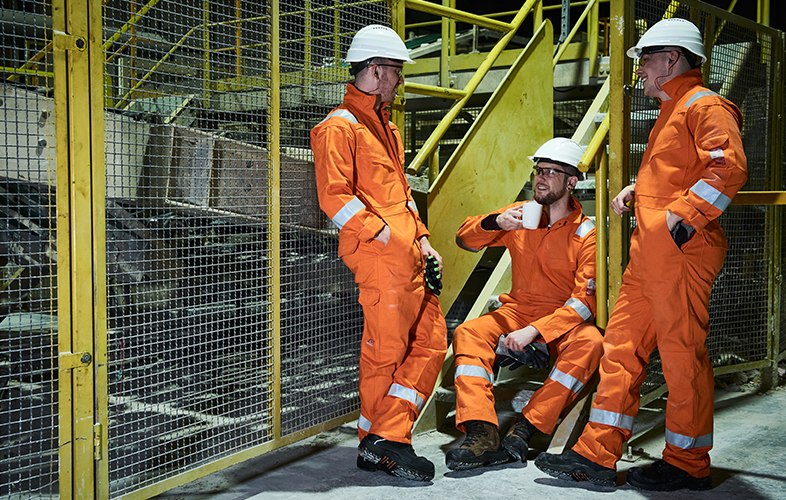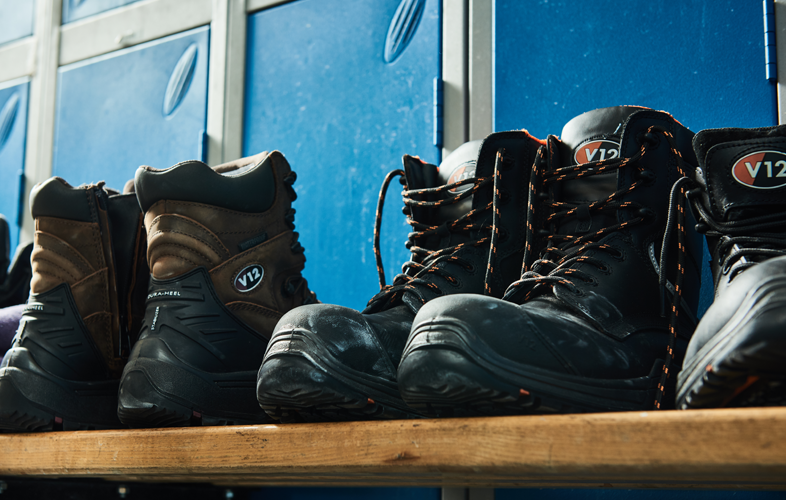Safety footwear has come a long way. In the past, the primary focus was on providing basic protection for the wearer, which would often come at the expense of their safety and comfort.
Thankfully, gone are the days of heavy, rigid and uncomfortable boots. Thanks to advancements in technology and design, there are some seriously high-tech safety boots on the market.
In this article, we look at the innovations revolutionising protection for safety boot wearers and explain why it’s crucial that when a manufacturer innovates, it’s for the right reasons – a superior benefit to the wearer.
ANTI-SLIP
The need for innovation
HSE statistics show that slips, trips and falls make up a third of all non-fatal workplace accidents.
A big problem with these accidents is that they can be caused by a range of things. These include:
- Wet, slippery or contaminated surfaces
- Changing levels or making a new step
- Mud clogging up the tread which compromises grip
InnovationS
To improve slip-safety, brands are emerging with a range of revolutionary developments. These include tread featuring specially curved anti-trip outsoles, varying lug pattern for water-dispersal, and built-in concave sole shells which adapt to different ground conditions.
.png?width=357&height=357&name=6%20(Boot%20On%20Step%20ladder).png) When V12 developed their slip-resistant sole units IGSTM (Intelligent Grip System) and STSTM (Stability Traction System), they were inspired by tyre technology to ensure maximum grip performance. This resulted in a hexagonal grip pattern to quickly channel away water and increase contact with the ground, wide-angled lugs designed to create a self-cleaning sole, and they also designed both soles with a 7º heel, which is the angle at which most slips occur.
When V12 developed their slip-resistant sole units IGSTM (Intelligent Grip System) and STSTM (Stability Traction System), they were inspired by tyre technology to ensure maximum grip performance. This resulted in a hexagonal grip pattern to quickly channel away water and increase contact with the ground, wide-angled lugs designed to create a self-cleaning sole, and they also designed both soles with a 7º heel, which is the angle at which most slips occur.
Ladder safety
The most common cause of fatal injuries? Falls from height. Rightly, it’s now considered such an important element of safety, there’s a new additional safety feature in the 2022 safety footwear standards, so a safety boot can be tested and labelled as carrying ladder grips as part of its slip-safety.
WATERPROOFING
The need for innovation
A waterproof membrane is essentially a bag sewn into the lining of a boot to stop water passing through. But many of these membranes are thick and solid, which means feet can often become sweaty, hot and susceptible to sores and blisters.
There have been big developments in membrane design which means moisture and vapour can exit the boot, so keep feet cool and dry which ensures the wearer avoids foot ailments like athlete’s foot and blisters.
InnovationS
Membranes are now being developed to work dynamically with moisture-wicking lining, so sweat and heat can be removed faster to reflect the wearers’ conditions.
Here are some manufacturers leading the way:
SYMPATEX
The Sympatex membrane is made of a hydrophilic material, meaning it absorbs water vapor and discharges it outward, protecting the body from moisture. Because the membrane structure swells with the moisture, it cleverly provides space for water vapour transport and fast evaporation.
Sympatex is also a highly sustainable membrane, as it’s 100% recyclable. Additionally, over 25% of the raw materials used in it are renewable bio-based, leading to 12% less CO2 emissions per kg polymer.GORE-TEX
The GORE‑TEX membrane includes billions of pores 20,000 times smaller than a water droplet. This keeps water out, but like the V-DriTM, each one of these pores is much bigger than a water vapor molecule, meaning sweat can escape.
Find out more about these waterproof membranes in our blog here.
METATARSAL PROTECTION
The need for innovation
While several met boots have been developed over the years, unfortunately the reliability and consistency of the protection they offer has varied. Reliable metatarsal protection in safety boots has been a challenge for manufacturers, as it is difficult to incorporate a solid, rigid and often heavy guard within a boot that has to move and flex.
More manufacturers are aiming to change this by developing new and advanced metatarsal designs.
Innovations

Pictured: The Invincible IGS metatarsal safety boot from V12 Footwear
New technological advances in metatarsal protection have led to some ultra-flexible metatarsal guards, and there are even some met boots that have been developed with guards which harden upon impact and then return to its original shape.
V12 Footwear's metatarsal boot Invincible IGS features a specially developed patented protective met system, the ExoGuard®, a carbon strap made of material used in radar and stealth aircraft. This protective strap is 200 times stronger than steel, providing an incredibly strong barrier against metatarsal impact.
Check out the ExoGuard® system in action:
And while all this technology might sound impressive, it’s not innovation for innovation’s sake – it's about enabling the wearer to return home safe to their families.
We developed Invincible because many met boots on the market have proven to perform inconsistently in the met protection test – and when it comes to safety, we don’t believe that’s good enough. The Invincible on the other hand consistently passed the metatarsal test, showing the real value of innovation in PPE is in safety, not modernity. See for yourself in the image below:

LEATHER-FREE UPPERS
The need for innovation
Many consumers are showing an increasing demand for non-leather products. As a result, the level of innovation going into developing synthetic materials in safety footwear like microfibre is on the rise.
Innovations
Microfiber is an innovative non-leather upper alternative. The fibres are finely split, making it soft and breathable, so it behaves and looks like leather.
A particularly innovative aspect of microfibre is its strength and durability. In fact, during safety boot testing, the way this advanced material is developed means it's actually quite common for it to outperform certain grades of leather in bond and tear strength tests. Synthetic uppers are also being produced with superior chemical-resistance and elasticity plus durability features such as mildew resistance.
So, rather than being what many have assumed in the past is a compromise compared to leather, microfibre is fast becoming a material that often outperforms leather.
FIT
The need for innovation
While laces are still the most common form of footwear fastening, there are some highly innovative alternatives that offer considerable safety benefits. A great example of this is the BOA® Fit System.
InnovationS
The BOA® Fit System is an advanced fit and fastening system featuring a micro-adjustable dial at the front of the footwear instead of a lacing system. This dial improves foot circulation as pressure points are reduced, and can also enhance safety because the dial can be adjusted without having to remove gloves in dangerous or challenging conditions.
See how the latest version of the BOA® Fit System is tested below:
INSOLES
The need for innovation
Foot pain such as Plantar Fasciitis and foot fatigue effects 10% of the population. And while some insoles on the market provide a general level of cushioning, many don’t target the specific pain points in the heel and arch, or provide proper support to promote lower limb alignment.
Innovations
The way feet are being assessed so customisable insoles work directly with the wearer's specific foot shape is developing. Manufacturers are using biomechanical tests to assess how muscles and ligaments are impacted during walking, and pressure mapping and 3D motion capture are also being utilized so insoles can distribute pressure more evenly and optimize foot stability.
Insoles are also now emerging designed with material which aligns with the individual wearer’s ideal centre of pressure to optimize balance, and specially designed forefronts that increase minimum toe clearance to reduce trips and falls.
When V12 developed its Dynamic ArchTM insole range, we collaborated with motion analysts and leading podiatrists to create insoles which comes in low, medium and high arch heights. Due to this bespoke cushioning under the arch, every wearer gets targeted, customised support to reduce foot strain and pain such as Plantar Fasciitis.
Find out more about this revolutionary insole range here.
THE FUTURE OF INNOVATION
Innovation in safety footwear is not slowing down. Some brands have even introduced digital insoles with embedded sensors providing real-time feedback to the wearer on foot pressure distribution and temperature via their smart phone.
Environmental innovation is also progressing, with some companies investigating how natural materials like corn, mushroom and pineapple can be used in footwear to make uppers and soles which are biodegradable as well as resilient.
INNOVATION FOR SAFETY
Clearly, there's no shortage of safety boot innovation - but when that innovation increases technology but not safety, it has very little point. And that's why V12 are constantly innovating - because we believe cutting-edge design is the best way to protect wearers.
Think you’ve seen it all? You've only scratched the surface! Find out more about how we use pioneering technology to maximise our footwear's safety on our innovations page.




.png)
